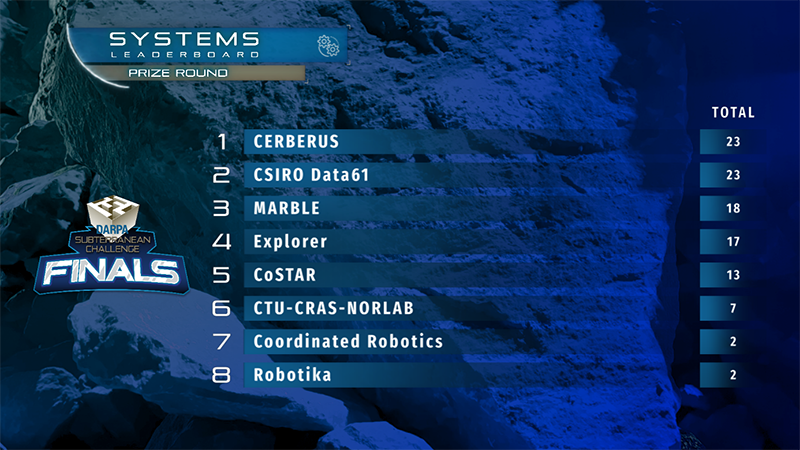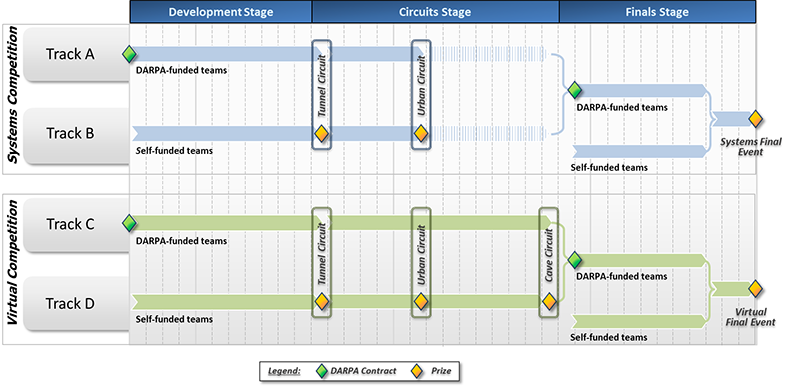Summary
The Subterranean (SubT) Challenge was a Defense Advanced Research Projects Agency (DARPA) program to develop innovative technologies that can augment underground operations. The SubT Challenge program explored new approaches to rapidly map, navigate, search, and exploit complex underground environments such as human-made tunnel systems, urban underground, and natural cave networks. These difficult settings present challenges for military and civilian first responders; hazards vary drastically across terrain that can change over time, making it too risky for personnel to enter.
In 2017, DARPA created the SubT Challenge to stimulate innovation and investment that helped close gaps in four key technical areas:
- Autonomy: Ability to map, navigate, and search in complex and dynamic environments without substantive human interventions
- Perception: Operating under varying and degraded conditions with the dynamic range to accommodate dust, fog, mist, water, smoke, low-light, obscured, and/or scattering environments
- Networking: Robust communications solutions that address the limited line-of-sight, effects of varying geology, and RF propagation challenges in subterranean environments
- Mobility: Systems with proven endurance and robustness to navigate mobility-stressing and dynamic terrain features including constrained passages, sharp turns, large drops/climbs, inclines, steps, falling debris, mud, sand, and water
SubT Challenge performer teams developed new approaches to address these challenges using robotic systems that can rapidly map, navigate, and search subterranean domains. The primary scenario of interest for the competition was providing rapid situational awareness to a small team of operators preparing to enter unknown and dynamic subterranean environments. Potential representative scenarios involve rescue efforts in collapsed mines, post-earthquake search and rescue in urban underground settings, and cave rescue operations for injured or lost spelunkers.
The main scoring objective for the SubT Challenge was the need to search for, detect, and provide spatially referenced locations of artifacts placed in the environment. Artifacts for the Final events included human (manikin) survivors, cellphones, backpacks, drills, fire extinguishers, vents, gas-filled rooms, helmets, ropes, and a SubT cube. Teams received the highest score by finding the most artifacts in the shortest amount of time and reporting them back to the DARPA Command Post. A report scored one point if the artifact type was correct and the location was correct within five meters. Each team was given a fixed number of reports to discourage false positives.

The SubT Challenge brought together over 300 competitors from 20 different teams; 8 Systems Teams and 12 Virtual Teams. Four of the teams competed in both the Systems and Virtual Competitions. Teams were composed of individuals, startups, universities, and large companies that spanned 11 countries (United States, Switzerland, England, Norway, South Korea, Sweden, Australia, Czech Republic, Canada, Spain, Germany) and 20 universities.
The SubT Challenge was organized into two competitions (Systems and Virtual), each with two tracks (DARPA-funded and self-funded). Teams in the Systems tracks developed and demonstrated physical systems to participate in live competitions on physical, representative subterranean courses. These teams focused on advancing and evaluating novel physical solutions in realistic field environments. Teams in the Virtual tracks developed software and algorithms using virtual models of systems, environments, and terrain to compete in simulation-based events.

Each competition comprised three preliminary Circuit events and a Final event. The Final event incorporated diverse challenges from all three environments into one course. Teams in the Systems Competition competed for up to $3.5 million in the Systems Final event, with up to $850,000 in additional prizes available for self-funded teams in each of the Systems Circuit events. Only self-funded teams were eligible for prizes in the Circuit events but were required to finish in the top five teams overall. Teams in the Virtual Competition competed for up to $1.5 million in the Virtual Final event, with additional prizes of up to $500,000 for self-funded teams in each of the Virtual Circuit events. All qualified teams were eligible for prizes in the Final events.
Office
Tactical Technology OfficeThis program is now complete.
This content is available for reference purposes. This page is no longer maintained.
Competition Resources
- Final event rules
- Artifacts specification
- Interface Control Document
- Questions and Answers (Revision 13)
Guides
Videos
Final event
